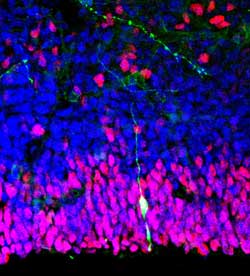The making and unmaking of stem-like, aggressive breast cancer cells

Reverting to a stem-like state, as shown here, helps breast cancer cells evolve around the blockages of current treatments. Image: Flickr/CodonAUG cc license.<br>
A University of Colorado Cancer Center study published as a featured article in the journal Oncogene shows how progesterone does just this – by suppressing a key microRNA, progestins return breast cancer cells to a stem-cell-like state in which they haven’t yet differentiated, and are thus more resistant to chemotherapies and more likely to carry a poor prognosis.
“The reason we were looking into the possible role of microRNAs in the dedifferentiation of breast cancer cells into this aggressive, chemo-resistant phenotype is that microRNAs tend to be good, druggable targets. Because one microRNA may regulate many genes involved in a cancerous signaling pathway, we hoped to find one target with many beneficial effects,” says Diana Cittelly, PhD, postdoctoral fellow at the CU Cancer Center and the paper’s first author. The study was a collaboration between the CU Cancer Center labs of Jennifer Richer, PhD, and Carol Sartorius, PhD.
Specifically, the study shows that progestins regulate miRNA-29 – a molecule that helps to decide which of a cell’s genes are and are not turned into proteins. This regulation of miRNA-29 creates a cascade that stimulates breast cancer cells to revert back to a stem-like state, marked by proteins CD44 and CK5. In animal models, these stem-like cells helped breast cancer evolve around the blockages of current treatments..
“We can manipulate this miRNA-29 in cell lines,” Cittelly says, “and we hope technology isn’t too far in the future that will allow us to deliver miRNA-29 in human cancers as well.”
Turn off the role of miRNA-29 and the hope is that breast cancers won’t be able to gain stem cell-like traits and lose their hormone dependence.
This work was supported by DOD BCRP Postdoctoral Fellowship W81XWH-11-1-0101 and DOD Idea Award BCRP W81XWH-11-1-0210.
Media Contact
More Information:
http://www.ucdenver.eduAll latest news from the category: Life Sciences and Chemistry
Articles and reports from the Life Sciences and chemistry area deal with applied and basic research into modern biology, chemistry and human medicine.
Valuable information can be found on a range of life sciences fields including bacteriology, biochemistry, bionics, bioinformatics, biophysics, biotechnology, genetics, geobotany, human biology, marine biology, microbiology, molecular biology, cellular biology, zoology, bioinorganic chemistry, microchemistry and environmental chemistry.
Newest articles

Red light therapy for repairing spinal cord injury passes milestone
Patients with spinal cord injury (SCI) could benefit from a future treatment to repair nerve connections using red and near-infrared light. The method, invented by scientists at the University of…

Insect research is revolutionized by technology
New technologies can revolutionise insect research and environmental monitoring. By using DNA, images, sounds and flight patterns analysed by AI, it’s possible to gain new insights into the world of…

X-ray satellite XMM-newton sees ‘space clover’ in a new light
Astronomers have discovered enormous circular radio features of unknown origin around some galaxies. Now, new observations of one dubbed the Cloverleaf suggest it was created by clashing groups of galaxies….





















